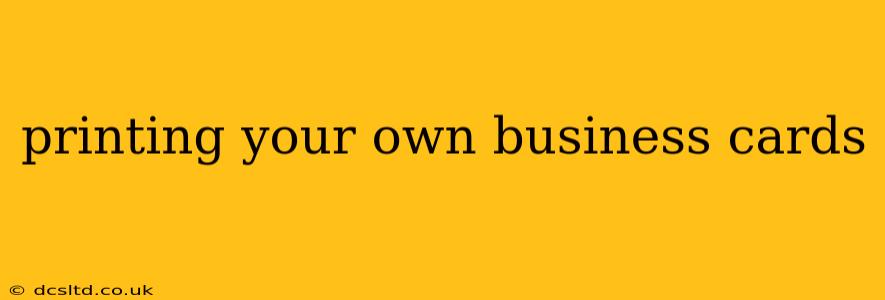Printing your own business cards might seem like a cost-effective and convenient solution, and in many cases, it is! However, achieving professional results requires careful planning and execution. This comprehensive guide will walk you through the process, addressing common questions and concerns to help you create business cards that make a lasting impression.
What are the benefits of printing my own business cards?
This is a frequently asked question, and the answer is multifaceted. The most significant advantage is cost savings. Printing in bulk through professional printers can be expensive. Printing your own allows you to control the quantity and, therefore, the overall expense. Furthermore, you gain complete creative control. You can design exactly what you want, ensuring your brand identity shines through perfectly. Finally, it offers greater flexibility. You can easily reprint cards as needed without waiting for external printing services.
What equipment do I need to print business cards at home?
The equipment you'll need depends on your desired level of quality and the quantity of cards you plan to print. At a minimum, you'll need:
- A printer: An inkjet printer is suitable for smaller runs, but a laser printer generally produces crisper, more professional-looking results, especially with thicker card stock. Consider a printer with good color accuracy for vibrant designs.
- Card stock: This is crucial. Choose a high-quality card stock with a thickness appropriate for your design. Thicker card stock (around 16-pt or higher) feels more substantial and professional.
- Design software: You'll need software like Adobe Photoshop, Illustrator, or Canva to create your design. Canva, in particular, is user-friendly and offers pre-designed templates.
What type of paper is best for printing business cards at home?
The best paper for home-printed business cards is a heavyweight card stock, typically 16pt or higher. Thinner paper will feel flimsy and unprofessional. Look for card stock that is specifically designed for printing; some stocks are coated to enhance ink absorption and prevent smudging. Consider the finish – matte, glossy, or textured – to match your brand aesthetic.
How do I design my business cards for home printing?
Effective design is crucial. Before you start, consider:
- Bleed: Extend your design slightly beyond the edges of your card to account for trimming. Most printers require a bleed area.
- Resolution: Use high-resolution images (at least 300 DPI) to prevent pixelation.
- Font: Choose a clear, legible font that aligns with your brand's personality.
- Information: Include essential details such as your name, title, company, contact information, website, and logo. Keep it concise and easy to read.
Are there any downsides to printing business cards at home?
While home printing offers advantages, it also has limitations. The quality might not match professional printing, particularly for large runs. You'll need to invest in the necessary equipment, and you'll also be responsible for cutting and handling the cards. Time investment is also a factor; designing, printing, and finishing cards takes time and effort.
How do I cut my business cards after printing?
After printing, you'll need to cut your cards to size. You can use:
- A paper cutter: This is the most accurate and efficient method for clean, straight cuts.
- Scissors: A less precise method, suitable for small quantities.
- Guillotine cutter: Offers a professional finish for larger quantities.
Printing your own business cards can be a rewarding experience, allowing for creative control and cost savings. By following these guidelines and carefully considering your needs, you can create professional-looking business cards that effectively represent your brand. Remember, high-quality card stock and a well-designed template are crucial for achieving the best results.
